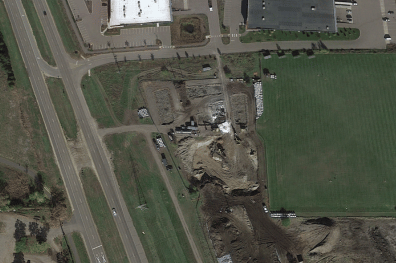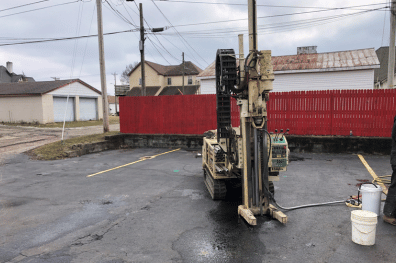ORIN treated highly contaminated unsaturated soils using a combination of advanced oxidation treatment chemistry and bio-available absorbent media (BAM). The chemistries were applied separately and mixed into the soils with a modified excavator. Approximately 9,120 cubic yards of soil were treated ex-situ within contained treatment pits of 4-ft thickness. The treatment zone was excavated in 570 cubic yard batches.
The Fenton’s treatment chemistry, a catalyzed hydrogen peroxide solution, was applied to break apart the clays, oxidize VOCs, and better homogenize the mixing of the BAM particulate. The site specific clean-up goal targeted less than 1.3 mg/kg TCE (or sufficiently meet TCLP standards), so as to allow the re-emplacement of treated soils into the subsurface. Post treatment composite samples determined the contaminant level reduction and need for retreatment if necessary.
The Challenge
The site presented significant remediation needs:
- 9,120 cubic yards of contaminated soil
- High TCE concentrations
- Clay-bound contamination
- Strict cleanup standards:
- TCE target: <1.3 mg/kg
- TCLP compliance required
- Future development requirements
The Solution: Strategic Ex-Situ Treatment
The team implemented a sophisticated batch treatment approach:
- Treatment Process:
- 570 cubic yard treatment batches
- 4-foot thickness treatment pits
- Modified excavator mixing
- Containment system
- Two-phase chemistry application
- Treatment Chemistry:
- Advanced oxidation technology
- Fenton’s Reagent application
- BAM integration
- Sequential application strategy
- Treatment Objectives:
- Clay matrix breakdown
- VOC oxidation
- BAM particle distribution
- Soil homogenization
- Leachability reduction
Impressive Results
The treatment achieved multiple objectives:
- Successful TCE reduction below standards
- Average TCLP: 0.009 mg/L
- Non-hazardous classification achieved
- Successful soil replacement
- Site ready for commercial development
Key Success Factors
Several elements contributed to project success:
- Strategic batch processing
- Dual treatment technology
- Modified equipment adaptation
- Comprehensive testing protocol
- Quality control measures
Innovation Highlights
The project demonstrated several advantages:
- Large-scale treatment capability
- Effective clay contamination treatment
- Successful soil reuse
- Commercial redevelopment enablement
- Sustainable remediation approach
Practical Applications
This success provides solutions for:
- Large volume soil treatment
- Clay-bound contamination
- Commercial redevelopment
- TCE contamination
- Soil reuse projects
Development Outcome
The successful remediation enabled:
- Multiple-use commercial complex
- Parking lot development
- Property value restoration
- Community benefit
- Economic growth
This case study demonstrates how effective remediation can transform contaminated industrial sites into valuable commercial assets.



